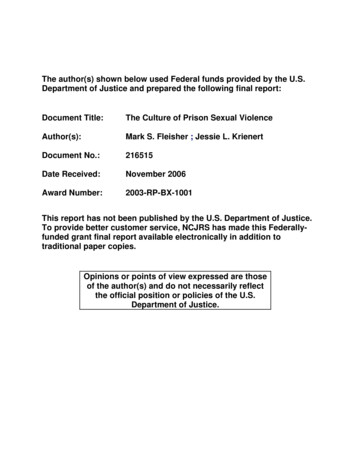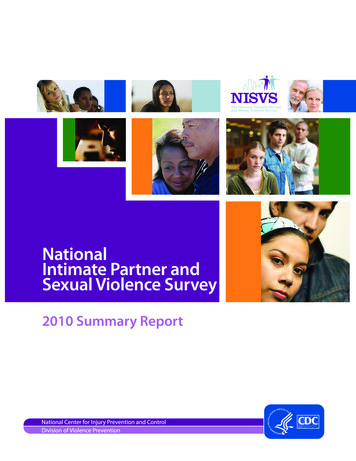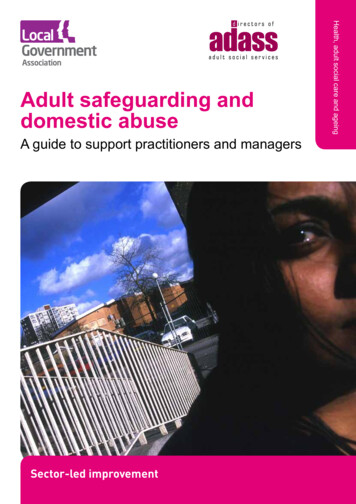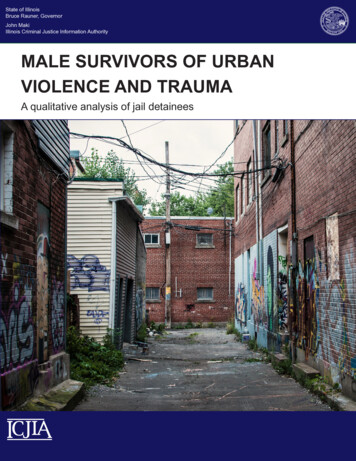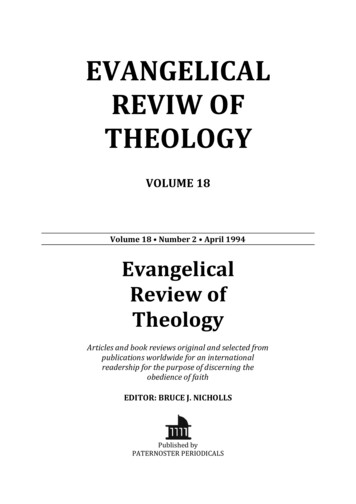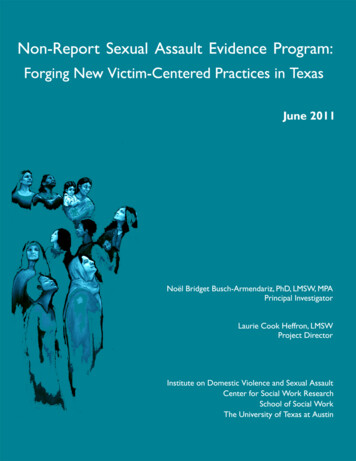
Transcription
Non-Report Sexual Assault Evidence Program:Forging New Victim-Centered Practices in TexasJune 2011Noël Bridget Busch-Armendariz, PhD, LMSW, MPAPrincipal InvestigatorLaurie Cook Heffron, LMSWProject DirectorStaff and Contributors:Regina Jones Johnson, DR PH, MSN, RNBruce Kellison, PhDJim Jarrett, PhDKaren KalergisShetal Vohra-Gupta, PhDShoshi OsiatynksiLeeann TerwilligerEden RoblesInstitute on Domestic Violence and Sexual AssaultCenter for Social Work ResearchSchool of Social WorkThe University of Texas at Austin
Institute on Domestic Violence & Sexual Assault
TABLE OF CONTENTSAcknowledgments4Executive Summary6Background10Methodology16Findings20Program Utilization22Impact on Victims and Professionals26Procedures and Protocols32Raising Awareness38Discussion and Recommendations42References44Non-Report Sexual Assault Evidence ProgramPage 2
Institute on Domestic Violence & Sexual Assault
ACKNOWLEDGMENTSThe research team extends deep gratitude and appreciation to the Sexual Assault NurseExaminers, rape crisis center advocates, law enforcement officers, victim services professionals,and prosecutors across Texas who shared their expertise, their time, and their insight, and whoshow daily commitment to, and compassion for, victims and their stories.Our thanks are also extended to the Texas Association Against Sexual Assault and the Office ofthe Governor, Criminal Justice Division, for their financial support of this project and theircommitment to improving services to victims and survivors of sexual assault.It just makes me realize how lucky we are to havesuch a good program. I was talking to someonefrom [another state] last week, and they‟re not as onboard with anonymous report sexual assault as weare. They don‟t even always call an advocate until acase is already done. That would be unheard ofhere. I guess we‟re just spoiled that we get alongwith most of the [SANE] coordinators. We have areally good rapport with all of them, and they callus and we call them. It‟s an open door.Non-Report Sexual Assault Evidence ProgramPage 4
Notes about LanguageThroughout this report, victims and survivors of sexual assault may be referred to simply as“victims” because this research is grounded in the criminal justice system and we wish toacknowledge that a crime has been committed. The word victim is not meant to be demeaning orjudgmental. The research team recognizes that at the time of their contact with medicalpersonnel, advocates, and/or the criminal justice system, individuals have survived acombination of sexual, physical, and emotional trauma. As advocates ourselves, our aim is tohonor the journey of all persons and to respect the way in which they name their experiences.In addition, this report describes the Non-report Medical Forensic Exam Program primarily fromthe perspective of Texas Sexual Assault Nurse Examiners (SANEs). However, the research teamacknowledges that some hospitals are conducting medical forensic exams, and possibly nonreport exams, without the assistance of SANEs.Institute on Domestic Violence & Sexual Assault
EXECUTIVE SUMMARYThe Non-Report Sexual Assault Evidence Program was created by Texas House Bill 2626 andbecame law in July 2009. The program allows sexual assault victims throughout Texas to obtainsexual assault medical forensic examinations without making a report to law enforcement and atno cost. This program is a new strategy designed to raise the low reporting and prosecution ratesof sexual assault. Non-report sexual assault examinations balance the needs of the victims andthose of the criminal justice system by allowing victims to preserve important evidence to useagainst their perpetrators and still take the time they need to decide whether to report the assault.The non-report program represents a major shift in operations for law enforcement, SexualAssault Nurse Examiners (SANEs), rape crisis center advocates, and the sexual assault victimsthemselves. This assessment aims to identify strengths and challenges within the program, and tomake recommendations to improve its implementation and usefulness to victims.In order to assess the non-report option, researchers conducted in-depth interviews (N 79) andWeb-based surveys (N 131) of SANEs, medical personnel, rape crisis center advocates, lawenforcement officers, prosecutors, and state agency personnel across Texas.FindingsThe implementation of the new non-report program has been highly successful and efficientduring its first two years, especially given the low level of public awareness and limitedorganized efforts to date to increase that awareness.As of May 2011, the Texas Department of Public Safety (DPS) had received 228 nonreport evidence kits for storage in the DPS facility in Garland, Texas. During this sameperiod, 11 kits were returned to local law enforcement due to a decision by the victim toreport the assault. This represents 4.8% of all non-report evidence kits received by DPSto date. For those cases that were converted from non-report to reported cases, the lengthof evidence storage time at DPS ranged from one week to eight months (with an averageof 9.6 weeks spent in storage).Non-Report Sexual Assault Evidence ProgramPage 6
The study participants, a wide variety of individuals in direct practice with sexual assaultvictims across the state, confirm that the non-report option, while still in its infancy, isworking relatively well. Those who have direct contact with the non-report program,primarily SANEs, are building procedures for, and becoming comfortable with, nonreport cases.Rape crisis center advocates are incorporating the non-report option into communityeducation activities.Most importantly, victims of sexual assault now have time to consider their reportingdecisions, since evidence from their assault has been collected and securely stored.Nonetheless, challenges remain if the program is to be fully utilized in the future. Findings fromthe study lead us to several recommendations for improvement of the non-report option in Texas.1. Increase awareness of the non-report option among:SANEs and medical personnel – including emergency room staffRape crisis center staff and volunteersLaw enforcementGeneral public2. Explore the use of medical forensic exams by male victims of sexual assault and promotethe non-report option among men and vulnerable populations.3. Explore the dilemma facing hospitals and SANEs who treat 17-year-old victims. Provideclarification to guide practice in conducting sexual assault exams for 17-year-olds.4. Consider the benefits and pitfalls of standardizing the storage protocols for evidence innon-report cases, in particular regarding the length of time evidence is kept in hospitalsbefore being sent to the DPS storage facility.5. Explore chain of custody issues. The Office of the Attorney General, Texas Departmentof Public Safety, and Texas Association Against Sexual Assault may provide guidance, ifnot policies, on these concerns.6. Explore the impact of lost evidence in non-report cases on the criminal justice system. Indepth analyses of cases that began as non-report cases and converted to reported casesthat were ultimately prosecuted would be useful to determine the true impact ofInstitute on Domestic Violence & Sexual Assault
differences in evidence collection for a sexual assault case that is initially a non-reportcase versus a traditionally reported sexual assault case.7. Increase education in the criminal justice system – among law enforcement, prosecutors,and juries – using trauma-informed clinical expertise, about trauma and why victims maynot initially report a sexual assault.Non-Report Sexual Assault Evidence ProgramPage 8
Institute on Domestic Violence & Sexual Assault
BACKGROUNDThe Non-Report Sexual Assault Evidence Program was created by Texas House Bill 2626 andbecame law in July 2009. The program allows sexual assault victims throughout Texas to obtainsexual assault medical forensic examinations without making a report to law enforcement and atno cost. This program is a new strategy designed to raise the low reporting and prosecution ratesof sexual assault. Non-report sexual assault examinations balance the needs of the victims andthose of the criminal justice system by allowing victims to preserve important evidence to useagainst their perpetrators and still take the time they need to decide whether to report the assault.The non-report program represents a major shift in operations for law enforcement, SexualAssault Nurse Examiners (SANEs), rape crisis center advocates, and the sexual assault victimsthemselves. This assessment aims to identify strengths and challenges within the program, and tomake recommendations to improve service delivery to victims.Sexual assault is best defined as any unwanted, non-consensual sexual contact with anyindividual made by another using manipulation, pressure, tricks, coercion, or physical force(Texas Association Against Sexual Assault [TAASA], 2011). The legal definition of sexualassault is outlined in the Texas Penal Code Section 22.011 and includes rape, sodomy, andpenetrating, touching, or oral sex where the victim is unwilling or unable to give consent, forreasons that include being under 17 years old, drugged, or unconscious (TAASA, 2011). Thisdefinition includes assaults on both males and females.Sexual assault is a traumatic event that may include other serious consequences including longterm physical injuries, sexually transmitted diseases, unwanted pregnancies, mental healthproblems, and reduced productivity (Centers for Disease Control and Prevention [CDC], 2009;Office for Victims of Crime [OVC], 2010; Tjaden & Thoennes, 2006). In addition to the majorhealth risks that sexual assault poses (CDC, 2009), it can instill intense fear of retaliation andextreme feelings of shame that deter many from reporting (Tjaden & Thoennes, 2006). Researchefforts, federal legislation, and wider prosecution of cases have made sexual assault a politicallypotent issue as the American public has discovered that its pervasiveness is a serious issueNon-Report Sexual Assault Evidence ProgramPage 10
(Government Accountability Office [GAO], 2007). While great progress has been made toprotect the confidentiality and privacy of victims of sexual assault, there is still much to be doneto protect victims and enforce their rights. Although the extent of the problem may always bedifficult to measure due to the underreporting of assaults, scholars, policymakers, and theprofessional community continue to make progress at identifying ways to work together to bestserve victims.Prevalence of Sexual AssaultAccording to the National Crime Victimization Survey of 2009, more than 125,000 peoplenationwide reported having been sexually assaulted that year. However, only 88,000 sexualassault cases were reported in 2009 to law enforcement (U.S. Department of Justice, 2010).According to the Texas Uniform Crime Reporting Program (Texas Department of Public Safety[TXDPS], 2010), the official statewide crime reporting system, an estimated 8,286 attempted orcompleted rapes were reported to Texas police in 2009. Of the total, 89% to 93% werecompleted rapes, while 7% to 11% were attempted rapes. Although the Texas Uniform CrimeReport accounts for all of the reported rapes of females over 18 years of age, it does not reportstatutory rape, sexual assaults of males, sodomy, or oral sex. Furthermore, these numbers onlycapture the total number of sexual assaults known to, and recorded by, the police.Given the limitations of the Texas Uniform Crime Report, researchers from The University ofTexas at Austin‟s Institute on Domestic Violence and Sexual Assault (IDVSA) in 2003 sought amore accurate estimate of the prevalence of sexual assault in the State of Texas (Busch, Bell,DiNitto, & Neff, 2003). Busch, et al., estimate that as many as 1.9 million adults (1,479,912females and 372,394 males) living in Texas have experienced sexual assault at some point intheir lifetime, affecting about 20% of Texas women and 5% of Texas men (2003).Female victims of sexual assault are typically assaulted by a man they know. Often this man isan acquaintance or a relative other than the victim‟s spouse or partner. In only 19% of the cases,the perpetrator is a stranger (Busch, et al., 2003).Institute on Domestic Violence & Sexual Assault
Sexual Assault Medical Forensic ExamsRegardless of whether or not a victim is willing to report the crime to law enforcement, victimshave the right to seek medical attention in the form of a sexual assault medical forensic exam.The sexual assault examination that is provided to the victim by a SANE or other medicalprofessional aims both to assess and treat injuries and to collect the forensic evidence forpossible prosecution efforts (Texas Office of Attorney General [TXOAG], 2010). Although thesexual assault examination has undergone some changes regarding when or if a victim has toreport the assault to law enforcement, many victims are still foregoing both the examination andthe reporting for reasons that deserve further examination.Sexual assault exams by SANEs began as a response by the medical and professional communityto an identified need for specialized services for victims of sexual assault, needs not otherwisebeing met by regular emergency services. SANE programs were first implemented in 1976 inMemphis, Tennessee, and officially came to Texas in 1979. Specialized nurses known as SexualAssault Nurse Examiners or Sexual Assault Forensic Examiners have the extensive knowledgeand training necessary to provide a medical forensic examination of sexual assault victims(Ledray, 1999). In addition to providing benefits to the victim through their invaluablespecialized knowledge, SANEs collect evidence of the assault that can later assist in successfulprosecution of the crime (Gray-Eurom, Seaberg, & Wears, 2002; McGregor, DuMont, & Myhr,2002).Across Texas, SANE coordinators organize and manage the efforts of SANEs and SANEprograms. The following map (Fig. 1) shows the locations of SANE coordinators in Texas asprovided by the Office of the Attorney General (OAG).Non-Report Sexual Assault Evidence ProgramPage 12
Figure 1. SANE coordinators in TexasNote: Listing provided by the Texas OAGNon-Report Sexual Assault Forensic ExaminationThe 2005 reauthorization of the Violence Against Women Act (VAWA) expanded existing grantprograms for sexual assault victims and added new requirements including that victims of sexualassault be provided with a medical forensic exam regardless of their participation or cooperationwith law enforcement. The deadline for compliance was January 2009, and Texas came intoInstitute on Domestic Violence & Sexual Assault
compliance when it passed House Bill (HB) 2626 in July 2009, implementing the Non-ReportSexual Assault Evidence Program.Underreporting of sexual assault may largely be due to the traumatic experience of sexual assaultand the difficulty with reporting the crime to law enforcement. The psychological effects of rapeoften include feelings of fear, hopelessness, anger, and humiliation, which can lead to inaction inreporting or seeking attention (Kirk & Okazawa-Rey, 2003; Wallace, 2005). Prior to the passingof Texas HB 2626, victims of sexual assault who sought to receive a sexual assault exam wererequired to report to law enforcement in order to receive that exam. When victims are recoveringfrom an attack, however, many are unable to undergo the further traumatic experience ofrepeating details of the incident to law enforcement.As a strategy to increase the prosecution of sexual assault cases, the Non-Report Sexual AssaultEvidence Program was developed to provide adult victims two benefits: 1) a sexual assaultexamination within 96 hours of the incident, and 2) the time to decide whether or not they willreport the assault. Through the program the victim can complete the sexual assault examinationand request that the evidence be kept confidential and stored (for a period of two years),available if or when she or he is ready to report. This time period allows the victim to accessformal or informal resources that may facilitate the healing process and to gain the strength thatmay be required for retelling the story to law enforcement. The program aims to alleviate theanxiety created by reporting an assault to law enforcement and to safeguard the forensic evidencefor later use by the criminal justice system.This major shift in scope of service delivery to victims requires appropriate training andassessment in order to ensure that all providers operating under this system and the victimsthemselves are working under the best delivery of services possible.Non-Report Sexual Assault Evidence ProgramPage 14
Institute on Domestic Violence & Sexual Assault
METHODOLOGYThis project‟s goal was to determine the impact, effectiveness, and efficacy of the Non-ReportSexual Assault Evidence Program in Texas. The study methodology was designed to assess theprocess of collecting and storing sexual assault forensic evidence in cases where the victim hasnot reported the crime to law enforcement, and to identify the strengths and gaps of this program.Research questions included:1. How is the non-report program currently being used?2. What are the processes that SANEs and hospitals follow in non-report sexual assaultcases?3. What are the program strengths and what are areas for improvement?4. What have we learned in the last year about sexual assault and non-reporting?5. What are the recommendations for improvement?Sample and Data CollectionTwo phases were undertaken to achieve these research goals. First, in-depth interviews wereconducted with professionals from the following five groups: 1) SANEs and other medicalpersonnel; 2) rape crisis center advocates; 3) law enforcement officers; 4) prosecutors; and 5)state agency personnel. Second, Web-based surveys were conducted with professionals fromsimilar groups. Table 1 provides data on the participants by group. Table 2 provides the numberof participants from each Texas Association Against Sexual Assault (TAASA) region, shown onthe map in Figure 2. A semi-structured questionnaire, with both closed and open-endedquestions, was developed for both the in-depth interviews and the Web-based surveys. Almostalways, the research conducted by IDVSA staff includes the voices and expertise of victims.However, given the need to maintain the confidentiality of the victim who has had a sexualassault exam but not reported the sexual assault to law enforcement, it was not ethical to includevictims in the methodology. One recommendation for future studies might be to talk with victimswho had non-report exams, then converted their case status by reporting the assault to lawenforcement.Non-Report Sexual Assault Evidence ProgramPage 16
Study participants were recruited using purposive and snowball methods. Researchers selectedparticipants based on certain criteria, such as their experience and expertise in providing servicesto victims of sexual assault and/or their role in the investigation or prosecution of sexual assaultcrimes. For snowball sampling, current participants were asked if they knew anyone who mightbe willing to be interviewed and who met the criteria.Table 1. Number of Participants by Group RepresentationCategoryInterviewWeb-Based SurveyParticipantsParticipantsSANE/medical personnel2442Rape crisis center4274Law enforcement98Prosecutor37State agency personnel10TOTAL79131Table 2. Interview Participants by Seven TAASA RegionsRegionNumber of ALInstitute on Domestic Violence & Sexual Assault79
Figure 2. Interview field sitesProtection of Research ParticipantsThis study was reviewed and approved by the Institutional Review Board (IRB) at TheUniversity of Texas at Austin. Written informed consent was obtained for this study from eachinterview participant. Web-based consent was also obtained from those participating in thesurvey. Participation in this study was voluntary.Non-Report Sexual Assault Evidence ProgramPage 18
Data Analysis ProceduresData from participants were analyzed using thematic and content analyses, an iterative process inwhich interview transcripts were read and reread by members of the research team prior tocoding. Each transcript was analyzed using line-by-line coding. Codes were grouped intothemes. Themes specific to conditions of, and challenges to, the Non-Report Sexual AssaultEvidence Program were identified within and across transcripts. The research team collectivelyconfirmed the results by reviewing them against the associated quotes from the transcripts. Datafrom the Web-based surveys were also analyzed using thematic and content analyses, anddescriptive statistics.Challenges to, and Limitations of, This StudyThis study utilized a non-probability convenience sample, and therefore the findings are notnecessarily generalizable to other professionals working in the field of sexual assault services,investigation, and/or prosecution.Due to the number of potential participants, and time and resource constraints, it was notpossible to conduct in-person interviews with all direct service providers and other keyinformants across the state. For this reason, the Web-based survey was added in order to increasethefeedbackfromareasthatwereInstitute on Domestic Violence & Sexual Assaultnotincludedinthesitevisitschedule.
FINDINGSFindings from SANEs, hospital staff, rape crisis center advocates, law enforcement, andprosecutors during the interviews and Web-based surveys concerning the Non-Report MedicalForensic Exam Program are organized according to the following four themes:I.II.Program UtilizationImpact on Victims and ProfessionalsIII.Procedures and ProtocolsIV.Raising AwarenessNon-Report Sexual Assault Evidence ProgramPage 20
Institute on Domestic Violence & Sexual Assault
FINDING I: Program UtilizationFigure 3 below illustrates the general step-by-step process utilized by the non-report program,from the time of assault until either 1) the destruction of forensic evidence or 2) its ultimate usein an investigation. Victims may become aware of the non-report option via public awarenesscampaigns or after having disclosed the assault to an advocate, hotline, SANE, other medicalprofessional, or law enforcement (prior to making a report).Figure 3. Process in non-report casesSexual assault occursVictim has a medicalforensic exam within 96hours of assault, butdecides not to report tolaw enforcementSANE forwardsforensic evidence toDPS storage facilityin Garland, TexasVictim maintainsdecision not toreport to lawenforcementForensic evidence isdestroyed after twoyears of storageVictim convertsher or his case byreporting to lawenforcementForensic evidence issent to lawenforcementinvestigating the caseAs of May 2011, the Texas Department of Public Safety (DPS) had received 228 non-reportevidence kits for storage in the DPS facility in Garland, Texas. During this same period, 11evidence kits were returned to local law enforcement due to a decision by the victim to report theassault. This represents 4.8% of all non-report evidence kits received by DPS to date. For thosecases that were converted from non-report to reported cases, the length of evidence storage timeat DPS ranged from one week to eight months (with an average of 9.6 weeks spent in storage).Non-Report Sexual Assault Evidence ProgramPage 22
SANE interview respondents reported having handled between one and 50 non-reports at thetime of the interview or survey (approximately 15 to 21 months following implementation of theWe haven‟t had nearly as many as Ithought we would have had, and Iwould like to see there be more. Ithink we‟re kind of afraid, becausewe have large numbers [of sexualassault cases] anyway, and if it wasreally, really out there, those whodon‟t want to report would just behuge. I think we‟re kind ofsurprised it‟s not more.state law). The two highest numbers reported during theinterviews (22 and 50) were from programs that begannon-reports with the passing of the federal law inJanuary 2009, five months before implementation of thestate law. Most SANEs reported having handled betweenone and five non-reports since implementation of thestate law.Of SANE survey respondents, 29 reported that their setting offers non-report exams, and sevenreported not offering non-report exams. It is not known why some sites are not offering nonreport exams, although lack of awareness of the option may play a role. Among those conductingthem, non-report exams represented between 1% and 22% of the total number of sexual assaultexams conducted by SANE respondents.All hospital personnel survey respondents (n 6) reported being able to offer non-report exams.The number of non-report exams conducted by hospital survey respondents ranged from none to17 (with an average of 5.6, although three had done none). The number of reported examsidentified by hospital survey respondents ranged from two to 250. Among those hospitalrespondents who had conducted them, non-report exams represented between 0.5% and 11% oftotal cases.Most participants were unaware of the number of non-report conversions. SANEs, in particular,often have little or no follow-up contact with a case unless they are called as a witness for theprosecution.Underutilization by Special PopulationsFirst, findings suggest that the non-report program has been underutilized by male sexual assaultvictims. Male victims are already thought to underreport assaults to law enforcement, and little isknown about their experiences with sexual assault exams. One SANE shared her theory on whyInstitute on Domestic Violence & Sexual Assault
males are not using the non-report option: “Once they have made this huge, huge step to go, theyare going to go all the way [and report].”Second, some programs along the border reported challenges in providing services toundocumented immigrant victims of sexual assault. While crossing the border, women inparticular are frequently sexually assaulted. As the drug wars have intensified along the border,violence and security concerns have also risen. Fear and mistrust may play a role in victims‟ability to access services. Since law enforcement involvement is not required, the non-reportprogram could potentially address barriers related to undocumented immigrants‟ relationshipwith law enforcement, serving as a point of access to other victim services.Challenges to Obtaining Accurate Data on Utilization of Non-Report OptionGiven that some non-report cases convert to reported cases before exam results are sent to theDPS storage facility and that some hospitals are storing non-report exams in-house, the truenumbers of non-reports are difficult to ascertain. Hospitals and SANEs (those who participate inthe DPS non-report program as well as those who do not) are not necessarily tracking thenumbers of reported cases versus non-report cases. Additionally, disclosure restrictions posefurther challenges to collecting accurate data on program utilization.It‟s a federal law; it‟s kind of likeI‟m not going to wait for the state.So we came together and came upwith a plan and signed it into ourprotocol for our county, onDecember the 12th of 2008, and wewere ready. We have been takingcare of [victims] since the federallaw was enacted, so we were readywhen the state law came in.Non-Report Sexual Assault Evidence ProgramPage 24
Institute on Domestic Violence & Sexual Assault
FINDING II: Impact on Victims and ProfessionalsFindings from both interview and survey respondentssuggest that the non-report program has a considerableimpact on victims, SANEs, hospitals, and the criminaljustice system. The impact is largely positive, although afew concerns remain.Victim ImpactThe non-report program supports victims and theirdecision-making about reporting to law enforcement inseveral ways. First, victims may not be emotionally orShe was kind of on the fence andhadn‟t made her decision. Iencouraged her to do that. I said thateverything will be here. It took twoweeks, and she called lawenforcement, and they called hereand asked if I had the kit here. I‟dalready forwarded it to DPS. I gavethem all the information as to howto get to it. She needed some time todecide. There was some reason shefelt she shouldn‟t do this – maybeshe felt threatened or something bythe assailant.physically ready to report, given the trauma they haveexperienced. They may also be focused entirely on getting the medical attention they need,reserving the option of reporting for a later time. For example, one respondent reported thatpeople “might want to go and do that first step and get the exam. You have given them somepower back. You have given them some control, so they may think, „Now I can go further.‟”Another respondent explained:If you can go in and get this stuff done and get your physical well-being taken care of andget the evidence collected, then you can think about what you want to do with the rest,instead of waiting so long that you end up being pregnant, that you end up having an STDthat can‟t be treated, [or] that you end up having things that could‟ve been taken care of ifyou had gone [to the hospital]. You get a resource in us. You get your medical well-beingtaken care of and someone to listen to you and someone who believes you.Second, victims may be afraid of legal, familial, or social repercussions. Another respondentrevealed how the non-report option fills a gap when victims have other fears of reporting, “Onewoman was on parole and was afraid the report would cause her problems. She must have hadNon-Report Sexual Assault Evidence ProgramPage 26
some problems before.” Several respondents noted that the non-report option is helpfulparticularly when the perpetrator is a family member or acquaintance:“Es
clarification to guide practice in conducting sexual assault exams for 17-year-olds. 4. Consider the benefits and pitfalls of standardizing the storage protocols for evidence in non-report cases, in particular regarding the length of time evidence is kept in hospitals before being sent to





